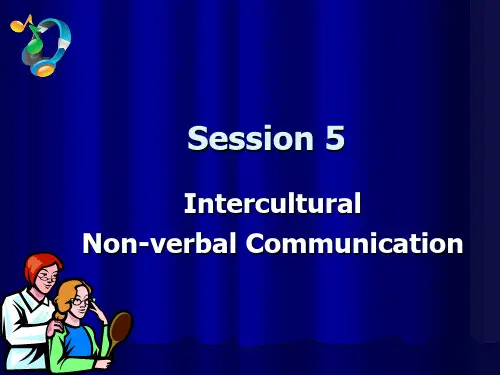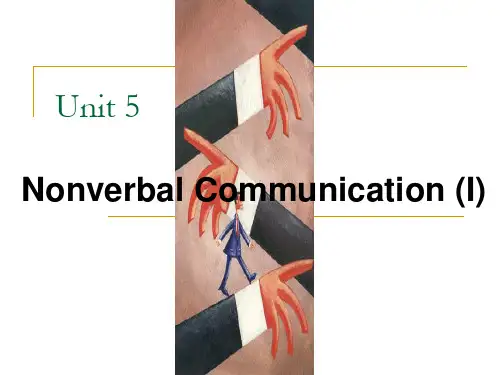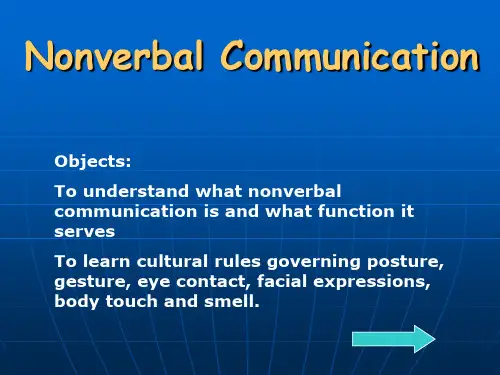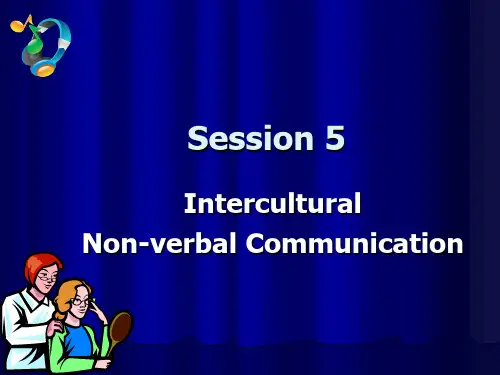跨文化交际英文版5 Nonverbal Communication (I)讲课稿55页PPT
- 格式:ppt
- 大小:3.68 MB
- 文档页数:55








Unit 5Nonverbal CommunicationIBC COURSEWARE OF EDWARD ZHANGObectivesI. What is nonverbal communication II. Nonverbal communication and culture III. Functions of nonverbal communication IV. The Importance of Nonverbal Communication V. Nonverbal communication: guidelines andlimitations VI. Categories of Nonverbal CommunicationIBC COURSEWARE OF EDWARD ZHANGIBC COURSEWARE OF EDWARD ZHANGI. Defining nonverbal communication• 1. Nonverbal communication involves all nonverbal stimuli in a communication setting that are generated by both the source and his or her use of the environment and that have potential message value for the source or receiver.• 2. Nonverbal messages may be both intentional and unintentional.IBC COURSEWARE OF EDWARD ZHANGII. Nonverbal communication and culture • 1. Much of our nonverbal behavior, likeculture, tends to be elusive, spontaneous, and frequently beyond our awareness.IBC COURSEWARE OF EDWARD ZHANG• 2. Culture is all-pervasive, multidimensional, and boundless; it is everywhere and in everything. The same is true of nonverbal behavior.IBC COURSEWARE OF EDWARD ZHANG• 3. Another parallel between culture and nonverbal behavior is that both need to be learned.IBC COURSEWARE OF EDWARD ZHANG• 4. Studying nonverbal behavior can lead to the discovery of a culture's underlying attitudes and values. It can also assist us in isolating our own ethnocentrism.IBC COURSEWARE OF EDWARD ZHANGIII. Functions of nonverbal communication • To repeat, complement, substitute for averbal action, regulate, and contradict a communication event.IBC COURSEWARE OF EDWARD ZHANGIV. The importance of nonverbal communication• 1.We make important judgments and decisions about others based on their non-verbal behavior.• 2. We use the actions of others to learn about their affective or emotional states.• 3. Many of our nonverbal actions are not easily controlled consciously.• 4. Nonverbal communication is important to the study of intercultural communication because a great deal of nonverbal behavior speaks a universal language.IBC COURSEWARE OF EDWARD ZHANGV. Nonverbal communication: guidelines and limitations1.It is important to remember that we are all more than our culture.2. In nonverbal communication, we often make differences more important than they should be.3. Nonverbal actions seldom occur in isolation.IBC COURSEWARE OFVI. Categories of Nonverbal Communication•1. Those primarily produced by the body: appearance, movements (kinesics), facial expressions, eye contact, touch.•2. Those the individual combines with the setting: space, time, and silence.IBC COURSEWARE OF2. Body movement (kinesics)•posture•gesturesIBC COURSEWARE OF3. Facial Expressions4. Eye contact and gaze5. TouchIBC COURSEWARE OFIBC COURSEWARE OFhe/she is ready to move at any time. his/her feelings, trying to calm down.•How Body Communicates, from head to toesIBC COURSEWARE OFHEAD-Nodding the head-“Yes”in most societies-“No”in some parts of Greece, Yugoslavia, Bulgaria, and Turkey•Tossing the head backward–“yes”in Thailand, the Philippines, India, LaosIBC COURSEWARE OFFACE IBC COURSEWARE OFIBC COURSEWARE OFEYES*Eye contacts-Encouraged in America, Canada, Europe-Rude in most Asian countries and in Africa*Winking eye-Sharing secret in America and Europe-flirtatious gesture in other countries*Closed eyes-bored or sleepy in America-“I’m listening and concentrating.”in Japan, Thailand, ChinaIBC COURSEWARE OFEars*Ear grasp-“I’m sorry.”in parts of India*Cupping the ear-“I can’t hear you.”in all societies*Pulling ear-“You are in my heart”for Navajo IndiansIBC COURSEWARE OFIBC COURSEWARE OFLIPS AND MOUTHCheeks*Cheek screw-gesture of praise -Italy-“That’s crazy.”Germany*Cheek stroke-“pretty, attractive, success”most EuropeIBC COURSEWARE OFTHE LIP POINTING*Kiss. In parts of Asia, kissing is considered an intimate sexual act and not permissible in public, even as a social greeting.IBC COURSEWARE OFTHE LIP POINTING •Finger tip kiss. In France, it conveys several messages, “That’s good!”“That’s great!”“That’s beautiful!.”IBC COURSEWARE OFIBC COURSEWARE OFTHE LIP POINTING*Open mouth. Any display of the open mouth is considered very rude in mostcountries.Fingers*The “O.K.”signal. (the thumb and forefinger form a circle) means*“fine,”or “O.K.”in most cultures,*“zero”or “worthless”in some parts ofEurope*“money”in Japan*an insult in Greece, Brazil, Italy, Turkey,Russia and some other countriesIBC COURSEWARE OFFingers*Pointing.*Pointing with the index finger iscommon in North America andEurope.*But it is considered impolite inJapan and China where theyfavor using the whole open hand.*Malaysians prefer pointing withthe thumb.IBC COURSEWARE OFIBC COURSEWARE OFHands*Of all the body parts, thehands are probably used most for communicating non-verbally.*Hand waves are used for greetings, beckoning, orfarewells.Hands*The Italian“good-bye”wave can be interpreted by Americans as the gesture of “come here.”*The American “good-bye”wave can be interpreted in many parts of Europe and Latin America as the signal for “no.”IBC COURSEWARE OFHands*Handshaking is a form of greeting in most Western cultures.*In the Middle East, a gentlegrip is appropriate.*In most Asian cultures, a gentlegrip and an avoidance of directeye contact is appropriate.IBC COURSEWARE OFHands*Right hand. The right hand has special significance in many societies. In certain countries in the Middle East and in Asia, it is best to present business cards or gifts, or to pass dishes of food, to get an attention, using only the right hand or both. *Left hand is considered unclean in much of the Middle East and in parts of Indonesia.IBC COURSEWARE OFHands*Clapping hands.*Russians and Chinese may use applause to greet someone.*In many central and eastern Europe,audience frequently clap in rhythm.IBC COURSEWARE OFNose*Holding the nose-“Something smells bad.”universal *Nose tap-“It’s confidential.”England-“Watch out!”or "Be careful.”ItalyIBC COURSEWARE OFIBC COURSEWARE OFNose*Pointing to nose-“It ’s me.”China*Blowing nose-In most Asian countries , blowing the nose at social gathering is ‘disgusting.’Arms*Some cultures, like the Italians, use thearms freely. Others, like the Japanese,are more reserved; it is considered impolite to gesticulate with broadmovements of the arms.*Folding arms are interpreted by somesocial observers as a form of excluding self, “I am taking a defensive posture,”or“I disagree with what I am hearing.”IBC COURSEWARE OF*Arms akimbo. In many cultures, thisstance signals aggression, resistance, impatience, or even anger.*Arms behind back, hands grasped is a sign of ease and control.*Arms in front, hands grasped, common practice in most Asian countries, is a sign of mutual respect for others.IBC COURSEWARE OFIBC COURSEWARE OFLegs & Feet*In Asia, do not point with your toes.*In Asia and some European countries, putting feet up on a desk or any other piece of furniture is very disrespectful.*Sitting cross-legged, while common in North America and some European countries, is very impolite in other parts of the world.IBC COURSEWARE OFCase Study•Study the following three cases and explain what messages smiles and laughter usually convey.IBC COURSEWARE OFCase Study1. In a Chinese classroom a girl was asked to answer a question. She stood up and smiled, without making any sound.2. When an American is parking his bicycle and the bicycle accidentally fall over, he feels embarrassed at his awkwardness, and is quite angered and humiliated when Chinese onlookers laugh.3. In the dining room, when an American drops a plate quite by accident and feels bad, and Chinese onlookers laugh, compounding his discomfort and causing anger and bad feelingIBC COURSEWARE OFSmile and laughter•Smile and laughter usually convey friendliness, approval, satisfaction, pleasure, joy and merriment.•In case A, the girl smiled to cover her embarrassment resulting from not being able to answer the question.•In case B and C, the laughter is not at the person or his misfortune –whether he is aIBC COURSEWARE OFSmile and laughter foreigner or a Chinese. It can convey a number of feelings: don’t take it so seriously; laugh it off, it’s nothing’such things can happen to any of us.IBC COURSEWARE OFSpace and Distance •Space includes the personal space and territoriality.•Animals and human beings both stake out to defend their territories.•The territorial invasion of a country may lead to the declaration of war. But people as individuals may not be so pugnacious (好斗的).• A more tangible form of communication between people is the use and control of space.IBC COURSEWARE OFNorth Americans’distance habit0~45cm:intimate lovers and family members45~80cm:friends (personal distance)130~300cm:acquaintances (social distance)>270cm:public space, not belong to oneself Behind:strangers speaking from behind are allowed to stand much more nearer.IBC COURSEWARE OFSpace and Distance•Personal spaceEdward T. Hall suggests that “each person has around him an invisible bubble of space which expands and contracts depending on his relationship to those around him, his emotional state, and the activity he is performing.”Based on his observations of North Americans, Hall developed four categories of distance in human interactions:IBC COURSEWARE OF•(1) Intimate distance: ranging from body contact to 18 inches, this distance is used for personal contact, comforting, and protecting.** 一英寸=2.54厘米IBC COURSEWARE OF•(2) Personal distance: from 18 inches to 4 feet, depending on the closeness of the relationship, in this distancing mode people have an visible “space bubble”separating themselves from others.** 1英尺(ft)=0.3048米(m)IBC COURSEWARE OF•(3) Social distance: from 4 to 12 feet, this distance is used by acquaintances and strangers in business meetings and classrooms.IBC COURSEWARE OF。



C r o s s–c u l t u r a l c o m m u n i c a t i o nThesis statement: This paper is mainly talking about the culture differences between several countries.Outline:Chapter 1: Language and culture in communicationChapter2: Culture shockChapter3: What’s in a nameChapter4: Social interactionChapter 5: Roles and relationsChapter6: Non-verbal communicationChapter 7: In other words.Chapter 8: From a primitive Tribe to a Global VillageConclusionChapter 1: Language and culture in communication There is no denying the fact that out daily lives depend largely on communication; without it we can’t know each other. So; we should come to realize that communication is of great importance.What is communicationIn total; communication can be divided into two parts; they are verbal communication and non-verbal communication. However; different people hold different opinions about communication. In general; if there is communication; there must have 4 cases: thereare at least two or more people; some contact between communicators;a language shared by communicators; an exchange of information has taken place. I just take the fist one for example. Suppose there is one person; there can’t be communication. Otherwise; he may talk to himself.Communication not just exist in human-beings There are five kinds of communications they are human communication; animal communication; human-animal communication; human machine communication; machine communication. So; Animals and machines can also communicate with each other.For human beings; how can we communicate with each otherExperts say that there are various kinds of communication. Nowadays; there are different kinds of tools for us to communicate .For people we can use telephone and computer to communicate with each other. By them; finally we can receive message.What is social situationWhen there are two or more people gather to do a job or an activity; then it creates a social situation. That is to say; an individual working alone can not constitute a social sA social situation may have two definitions. One is given bythe community; and the other by the participants. Finally; we should notice that being polite plays a crucial role in social situation. Chapter2: Culture shockWe should not only know what communication is but we should know what culture shock is.In contemporary society; as our country is developing faster and faster; more and more foreigners will come to our country. Communicating with foreigners is an interesting thing. However; there is no doubt that it can easily cause misunderstanding which is called culture shock. There are several kinds of culture shock.Hospitality: First of all; in Britain; hospitality can not be judged by whether hosts put the food into your dishes; in there; everyone has own dishes; everyone helps themselves. By contrast; in our country; when we have guests; hosts may put the food into guest’s dishes to sh ow their hospitality; so this is different.Politeness: When it comes to this word; in many case; foreigners were described as being polite than Chinese. For example; when we finish work; foreigners may say thank you to us; although it is out duties. However; for Chinese; they seldom say thank you because they think someone who serves them are their duties.What’s more; when we get along with foreigners; we should avoid asking their salaries; jobs and religious and so on. For the young;it’s all right to a sk their ages; for the adults; this question is not allowed; especially for the females. But in china; these questions are allowed.In conclusion; when we face these culture shocks; it is better to keep a cool head; and then make an adjustment toward it; finally; we can cope with it. As time goes by; we can adapt it. For example; American Jewish and Israel; the two groups are equal and integration. Both groups have positive attitudes toward one another. So I am sure that after learning this unit; we can know a lot about culture shock and can easily communicate with foreigners.Chapter 3: What’s in a nameThe topic of unit three is “what’s in a name ” As is known to all; the English name is different from the Chinese name .The Chinese name consists of family name and given name ;with family name put first. But in contrast; the family name of English name is coming last. Most English people have three names. The last name ; or surname is the family name .This is the family name of the father and is given to all his children. And the first name is given to the child at birth; which is called “given name”. And another name used to refer to them is Christian name.However; Chinese name can give all sorts of information about a Chinese people .they may give the address; the birthday ;and alsotell us about the family relationship; ethic groups; sex and the parents’ expectation for their children. At the same time; in Chinese the use of kin terms is closely related to age politeness; such as that children are expected to call an old lady; Granny and call a male adult who is older than their fathers; elder uncle. The appropriate and extend use of kin term according to age is taken as reflecting good manners.Chapter4: Social interactionWhat is “social interaction”. It is the topic of unit four. Social interaction is an important way of human existence; and it is different from other animals’communication. And it’s meaningful. Different countries have different social interactions. Many Chinese people tend to ask age; marital status; and even salary when they meet each other first. To the Chinese people; these are open conversational topic. and Chinese people pay much attention to family life. So in their spare time; they will talk about the family member features as a common topic. It is so natural. And the salary is not a secret .and when a Chinese offers refreshments or drinks to his colleague; his colleague often declines the offer politely; because he don’t want to trouble the person who offers. And it also shows his politeness. But in western countries; if you ask the person who meet you first about these; they will feel sobad. They think it is not polite.Do you know how English native negotiate a time to meet .from the text I know that you may find their way of settling on a time is quite similar to our own; that is ; normally one gives or suggests a time; then the other may find it is not suitable and suggest another time; and finally a time is fixed which suits both.Consequently; you can know from above; different countries have different habits.Chapter 7: In other words.Different languages cause some misunderstandingsThere are many countries that their language is the same. such as America ; British; Canada; Australia;and so on; they all speak English; people from America and British speak different varieties of English. They usually find little difficulty in understanding each other. However; there are some differences which may cause some misunderstanding; because of profusion of synonyms that they use different words to refer to the same thing. But for other countries which do not speak English they hardly understand the idioms; for example “face the music” in America it means to accept the criticisms; unpleasant consequences; etc . it probably comes from the custom in some Western armies of punishing soldiers to the sound of beating drums; if a person who is come from Chinamay comprehend that enjoy himself by listening to music. on the contrary;they can not understand the meaning of Chinese idioms.There are some similar in languagesWith the exception; both English and Chinese have many such idioms that refer to animals; and some animals have similar associations in both cultures: deer; for example ; are bloodthirsty and cruel; ect . But some other animals have rather different associations; like dogs; in the eyes of English-speaking people;dog is loyal ;but in the eyes of Chinese it aways contains derogatory sense are seen rather differently from the way appear to us. About proverb; since human experiences and observations of the world are in many respect similar. in spit of the dissimilar cultural backgrounds of the Chinese and the English-speaking peoples; the number of proverbs or saying in two language that are equivalent or closely approximate is rather surprising.Swearwords is the taboo for every countries Every language contains a special group of taboo words which people avoid using because they find them embarrassing or offensive. In many languages; swearwords are taboo; this is generally true of both English and Chinese. In English; certain swearwords seem to be more offensive than others and consequently the social prohibition against their use is stricter.Chapter 8: From a primitive Tribe to a Global VillageAnimals might have astonishing ways of showingtheir emotions and feelings.This unit takes us back in to history; inviting us to reflect upon how man has extended his limbs and senses by using new technologies. Nowadays; the technologies are so advanced that communication over long distance can be done in a split of a second. People all over the world are living; quite literally; in a global village. In the textbook; we have learned that animals might have astonishing ways of showing their emotions and feelings. The way different kinds of animals behave; have fascinated great minds since Plato and AristotleCommunication is covering everywhereOne point that is beyond doubt is that our ancestors were extremely handicapped --- in comparison with us now --- in communication. From the Stone Age; to the present day; over 2;000;000 years; man has done his best to extend himself in order to improve his way of communication. Writing; printing technology; postal services; telegraph; telephone; radio; picture communication; television; computer and laser technology; internet --- these have extended man’s mouth; eyes; ears; hands; legs; inshort the whole body beyond a house; a village; a county; a province;a country; an ocean; a continent; and even beyond the mother earth to the moon and the Mars. Going global is great; but an entirely different tone was heard: Globalization is a menace to mankind. Globalization will make the powers more powerful but the weak is weaker and the poor is poorer.ConclusionDifferent countries have their own cultures; so it causes the different cultures .Consequently; sometimes the people come from different places may cause some misunderstandings. After learning this textbook we can get along well with people all over the world.Finally; through this paper; we can learn more knowledge.。
Unit 5Nonverbal communication课前谚语+名言:1、I’s not what he said, but the way he said it.——English saying2、There is a language in her eyes, her cheeks, her lips.——William Shakespeare案例一:个人空间马克最近从丹麦搬到了悉尼,在一家澳大利亚公司当销售员。
他被邀请加入当地的一个俱乐部。
有一天在一个晚会上,一个女成员走近他,马克立即通过谈论展现出了他的兴趣。
起初聊天进行的很顺利,但随着谈话的进行,马克逐渐的向她靠近,而那位女士似乎离他越来越远,并显得很不自在。
当马克正要问她有关于澳大利亚习俗的问题时,站在旁边的一个男士往这边瞟了一眼,她找了个借口离开,去和那个男人说话。
留下马克傻傻的站在那里,他不知道为什么他们的交谈如此突然地停止了。
Question:Why did that women suddenly stop talking with mark and turned to another man?注释:这是一个对身体距离理解不同造成的误会。
在丹麦,正式场合中,个人空间大概在20厘米-30厘米之间。
而在澳大利亚,这样的场合需要40厘米-50厘米的身体距离。
所以丹麦人习惯近距离交谈,澳大利亚人习惯远距离交谈。
在这个情况下,马克尝试去建立自己正常的个人亲密空间,侵犯了澳大利亚女士的空间,正因如此,她感到了某种威胁,失去了舒适感。
就在那时,身旁的男人给了她一个离开的机会。
如果马克对于澳大利亚人所期待的个人空间有所了解的话,或许这个谈话会有所不同。
案例二:使用当地语言的问题。
弗兰克为了做研究的目的从澳大利亚来到中国,为此,他在大学里刻苦学习中文,并且能用中文很方便的和人交流。
而当他到达北京以后,他开始和当地人交谈,询问方向和建议。
尽管他几乎都是用中文和他们交流,但是他发现周围的人有时候会笑着用英语回答他,尽管他们对英语知之甚少。
2010·08ZHI SHI CHUANG16论文展台跨文化交流中的非言语交际Part Ⅰ.Introduction“Nonverbal communication ”,like our verbal language,is also a part of our culture.But not all nonverbal communication means the same thing in differ-ent cultures.Different people have different ways of making nonverbal communication.In order to communicate effectively in a foreign language,one should know also the gestures,body movements,mannerisms and etc.that accompany a par-ticular language.Observation shows that a truly bilingual per-son switches his nonverbal be-havior at the same time he switches languages.This makes communication easier and better.Part Ⅱ.The Necessity and Importance of Learning Nonv-erbal Communication in Cross-Cultural CommunicationWe could easily find that the same posture may have dif-ferent meanings in different cul-ture.For example,touching one's ear is protection against the evil eye in Turkey,however,it denotes jeering at effeminacy in southern Italy,but a sign of re-pentance or sincerity in India;crossing one's legs means a sign of being relaxed in the United States,but it is impolite in Chi-na.The above tow examples remind us that although much of nonverbal communication is universal,many of our nonverbal actions are touched and altered by culture.Hence,we should know the potential messages carried by the nonverbal behav-iors if we want to establish communication with foreigners without obstacles.Nonverbal communication is an important media through which people communicate with each other.It refers to the pat-terns of facial expressions and gestures that people use to ex-press their feelings in communi-cation.The specialist on non-verbal communication research —fle.Angles,once said:“Once it was lost,a baby couldn ’t have grown into a normal person ”.It s also true to the juveniles.In school educa-tion,nonverbal communication plays a positive role in cultivat-ing the students characters.Part III.The Functions of Nonverbal Communication and Application in Daily Life1.Nonverbal communication plays important role in commu -nication when existence of obsta -cle in verbal communicationWe all know that dumb person use their gestures and body languages to communicate.If a person was born to dumb and deaf,he could not under-stand all the verbal language since he was a baby.How could other people communicate with him?He must learn a special sign language —a kind of non-verbal language.Only he learn the sign language,can he com-municate and exchange thoughts with other people.From this real example,we can understand the significance of nonverbal communication.2.Sometimes it is better to use nonverbal communication than verbal communicationNowadays,almost every young people have got a cell phone,including me.If we only use cell phone to make a call,day by day,we are surprised to find how much we cost at the end of the month.In order to save money,most people choose to send short messages,which is摘要:非言语交际是跨文化交流的重要手段。